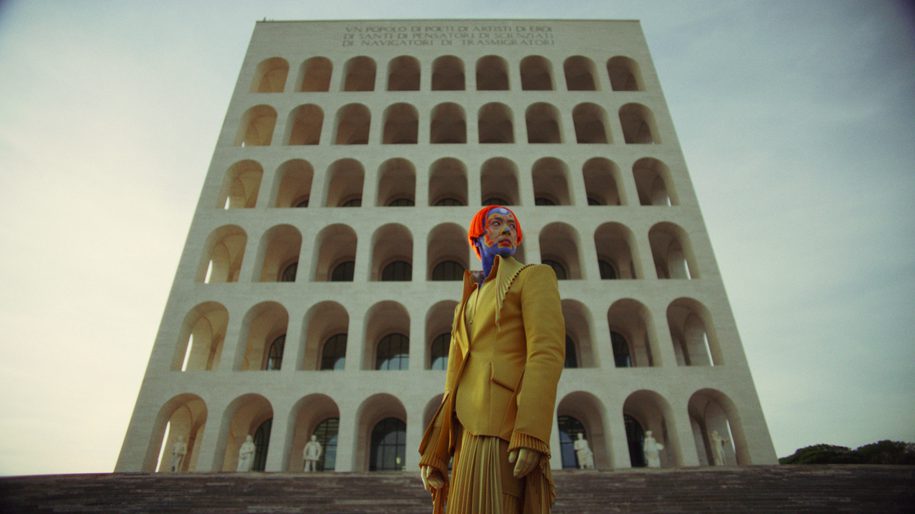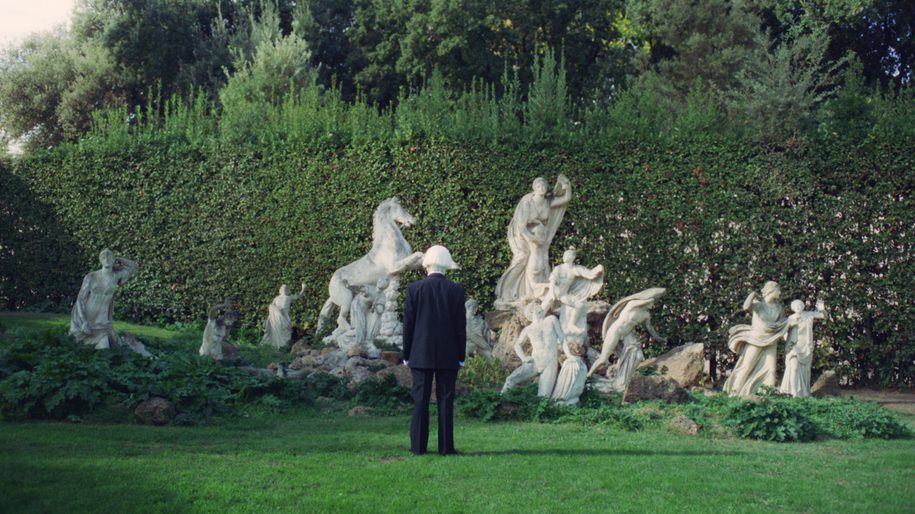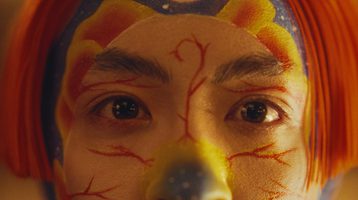Names in the Clearing: On Sin Wai Kin’s Dreaming the End
The Film London Jarman Award 2024Maxi Wallenhorst

Sin Wai Kin, Dreaming the End (2023), film still. Commissioned by Fondazione Memmo Rome. Produced by Mira Productions. Courtesy the artist.
Once there was a name who lived in name with name’. In one version, Sin Wai Kin’s nonlinear film Dreaming the End opens with a book from which names and nouns have been replaced by just the word ‘name’. In the salon of a suffocatingly luscious palazzo, a reader of this book, serving a strikingly feminized look, almost drowns in its repetition: ‘Name. Name. Name. Each other’. A droning noise simmers as though this were a threat when the reader joins a second, husband-coded character in the dining room to feast on nightmarishly geometrical apples. The latter begins to explain something but again, every single word is the word ‘name’. Name-dropping in its purest form.
In Dreaming the End, the two protagonists themselves remain unnamed but some viewers may recognise them from the ever-expanding universe of Sin’s body of work. With their series Portraits (2023 - ongoing) in mind, for example, one might extrapolate from their elaborately painted faces that the red-haired, aggressively mansplain-y character goes by the name of The Storyteller. The many-eyed reader, wearing a high femme peroxide wig, is likely called Change. Inspired by Cantonese and Peking opera, the full faces of drag, and cubist costume design, Sin’s characters vibrate with both an enigmatic allegorical force and hyper-specific performative details: the thick texture of make-up on skin, their voices hoarse in careful modulation. Throughout the film, Change and The Storyteller can be seen in different types of drag — at the dinner table however, they clearly reenact the endless monologues and chewing noises of heterosexual dichotomy until they become unbearable. ‘What are you doing?’, Change finally interrupts The Storyteller. ‘I’m telling a story’. ‘Are you describing a reality?’, Change responds, somewhat cheekily. Their exchange makes palpable how the distinction between those names that are brutally applied and those reduced to fiction is a power game.
Change seems to escape their horrible dinner through the arches of a brutally slick façade. A landmark of fascist architecture, the Palazzo della Civiltà Italiana was built in preparation for the 1942 World’s Fair, a celebration of Mussolini that never was. Postwar Italian cinema has often turned to the Palazzo’s anal arches to represent fascism and the way in which it lives on in the country’s fixations. In his contribution to the 1970 anthology film Bocaccio '70, for example, Federico Fellini uses Mussolini's fever dream of militant neoclassicism as a backdrop for Anita Ekberg, who appears as a monstrously voluptuous giantess. Sin, however, contrasts the Palazzo with the even more disturbing, rigorously denaturalized femininity of Change. This seems especially poignant at a historical moment in which Italy’s (supposedly post-) fascist future is, in the hands of prime minister Giorgia Meloni, female.

Sin Wai Kin, Dreaming the End (2023), film still. Commissioned by Fondazione Memmo Rome. Produced by Mira Productions. Courtesy the artist
Dreaming the End was shot over the course of a year in Rome, a place that once glowed with the epithet theeternal city, before the climate catastrophe made such names sound rather antiquated. Rome is so full of names, both aggressively historicized and forgotten, it seems to disorient The Storyteller and Change as they roam the gardens of the Villa Medici. In Civilization and its Discontents, Freud famously describes Rome as an allegory of how, in the unconscious, even what seems to have long since vanished remains eerily tangible: ‘Now let us, by a flight of imagination, suppose that Rome is not a human habitation but a psychical entity with a similarly long and copious past — an entity, that is to say, in which nothing that has once come into existence will have passed away and all the earlier phases of development continue to exist alongside the latest one’. Curiously, however, Freud soon dismisses this image ‘for it leads to things that are unimaginable and even absurd’.1 Sin’s use of Roman landmarks stays faithful to this absurdity—and takes it one step further. They dare to imagine a kind of clearing at the centre of European iconography, a place where the unimaginable simultaneity of names, future and past, to which Freud alludes, can be more fully articulated. A place relieved, if only for a moment, of the pressure that makes names so categorical. And thus, instead of dutifully representing the ideals that modern story-tellers have projected onto antiquity, the statues in the Medici gardens suddenly begin to tremble with almost comically crude animation. They talk back, despite being headless. ‘The past, the present, and the future’, one of them reminds a curious Change (now donning a dashing suit complete with deconstructed bowtie), ‘are one theatre’.
In intimate conversation with various statues in the gardens, Change and The Storyteller reflect on the messy entanglement of narratives and materiality, in other words, on performativity. ‘Your story is changing my body’, Change observes, and throughout, the film conveys a visceral sense of how painful and exciting that can be. A name might precisely be the device whereby a story changes a body, since names can become an oppressive label or be just a noise. Perhaps this is why the problem of naming is at the heart of contemporary gender politics. Many languages rely on pronouns because names are ultimately the too unwieldy and idiosyncratic, too embodied, to be folded into the casual syntax everyday life requires. The gendered nature of some pronouns speaks to the ill-fated attempt to make them resonate with the ways in which social inequality is organized. Trans and non-binary struggles, however, are fighting not only for a new set of names or pronouns, nor merely their abolition. They are demanding a different relationship to the act of naming itself, often aware that this will only be possible through the radical transformation of very material conditions.
The ways in which many people are currently coming up with new names for body parts, intimate relationships, sexual orientations, can sometimes seem silly, overly academic, hyper-specific (and often they are!). At their most strategic and dialectical, however, they also prefigure a world in which a name could name something different entirely: a precision instrument of social relationships rather than a naturalised accident. Performing a subtle dance, The Storyteller gives a visceral account of how alien naming actually feels: ‘I haven’t gotten used to the feeling of the vibrations in my throat or the shapes my mouth is making’. Dreaming the End holds onto that feeling, to the possibilities that become unspeakably nameable in its wake.
1 Sigmund Freud, Civilization and its Discontents (1930), in The Standard Edition of the Complete Psychological Works of Sigmund Freud, Vol. 21, trans. Alan Tyson, Alix Strachey, Anna Freud, James Strachey (Vintage, New York: 2001), p. 70.
Maxi Wallenhorst is a writer based in Berlin. She’s currently working on a dissertation on a trans poetics of metabolism at Leuphana University as well as a novel.



